|
|
| Oracle v. Google - Proof of Patent Marking |
 |
|
Thursday, December 01 2011 @ 10:45 AM EST
|
A few weeks ago Judge Alsup denied Google's motion for partial summary judgment on the issue of patent marking (i.e., Oracle's failure to mark products embodying the apparatus claims it is asserting against Google). (see Google Wins One and Has a Second Deferred) At that time Judge Alsup directed the parties:
The Court is concerned over whether this issue will devolve into an “infringement” type analysis at trial of various Oracle products and methods to determine if they practiced any of the claims to be tried, throwing yet another complication into the trial. By NOON ON NOVEMBER 30, 2011, each side is requested to please file a five-page statement explaining the extent to which this will be so and how the complication can be mitigated.
Oracle didn't need five pages to state its position. (634 [PDF; Text]) They could just as well submitted Bobby McFerrin signing "Dont't Worry, Be Happy!" Oracle maintains that all of the witnesses are Oracle witnesses (Google having not identified any witnesses on the subject), and those witnesses can be handled in the context of the trial.
Google, on the other hand, used all of the permitted five pages to explain that it isn't quite that simple. (635 [PDF; Text]) According to Google, it does plan on presenting evidence of "the
practice (or failure to practice) by Oracle and/or its licensees of each of the six patents still being
asserted by Oracle in this action." Google suggests that the presentation of this evidence could disrupt the trial, depending on the extent of the dispute. Consequently, Google suggests that the parties "narrow the issue now, by
identifying the patents (if any) over which there is a legitimate dispute about whether Oracle or
its licensees practiced the asserted claims."
One worthwhile distinction to draw between the two communique's to the court. Oracle makes no mention of licensee products that may practice the asserted patents, focusing solely on Oracle products. Google makes clear that Oracle licensee products are also in the mix.
How Google views the Oracle position is quite clear:
Throughout the course of this litigation, Oracle has argued that this case is about “Java.”
It has broadly characterized the patents-in-suit as “Java” patents, represented that the asserted
patents were implemented by its “Java” products, and asserted that the patents as a group are
crucial to the use of Java. Oracle’s infringement contentions identified numerous of its Java
products as allegedly implementing each of the asserted patents. Oracle and its damages expert
have argued for enormous monetary damages and an injunction for alleged infringement by
Google of “Java patents.” Oracle repeatedly refers to the patents-in-suit as “Java related
patents” in its trial brief. Oracle employees testified at Rule 30(b)(6) depositions that the ‘104,
‘205 and ‘702 patents were implemented in Oracle’s Java products.6 Oracle’s patent validity
expert attempted to demonstrate commercial success of the patents (to rebut evidence of
obviousness under the secondary considerations doctrine) by claiming that Oracle’s products
practiced the ‘104, ‘205 and ‘476 patents. And Oracle made the same argument in
reexamination proceedings of the ‘720 patent.
Despite its repeated rhetorical claims that its products practice the patents, Oracle seems
to have proof problems. For example, it refused to provide a Rule 30(b)(6) witness to testify
regarding practice of the ‘520 or ‘720 patents, stating: “We can confirm that we will not present
an Oracle employee or officer at trial to testify regarding the conception, reduction to practice, or
actual use of the inventions of the ‘520 and ‘720 patents.” And then, despite its constant drumbeat of claims that the patents are essential to Java, Oracle opportunistically reversed course
when opposing Google’s motion for partial summary judgment on marking, claiming that its
products do not necessarily practice the asserted claims.
Oracle should not be permitted to have it both ways and come to trial with two directly
conflicting factual positions. If Oracle maintains that its products practice the patents, then it
bears the burden of proving that it marked those products accordingly. Alternatively, if Oracle
now maintains that its Java products do not practice the asserted patent claims, Oracle’s trial
story that Google allegedly practices its key patented “Java” technology is false and misleading
to the jury. Indeed, if Oracle’s position for marking purposes is that there is no proof that its
products practice the asserted claims, then Oracle should not be permitted, in connection with its
patent case, to describe the patents as “key Java technology.” Moreover, failure to practice
would only further undermine Oracle’s already wildly-exaggerated patent damages calculations,
as those calculations rely upon alleged harm to Oracle’s “Java” products and purported
fragmentation of “Java” technology, and altogether fail to adopt a reasonable valuation for
“Java” patents that even Oracle itself had no use for. And it would also severely undermine the
fundamental premise of Oracle’s request for an injunction, namely Oracle’s allegation that it
“practices . . . the six Java-related patents” and an injunction is therefore necessary to “prevent
Google from further fragmenting the Java platform and undermining Oracle’s and others’
investments in Java.”
Google goes on to press for dealing with the issue right now by suggesting Oracle identify "each Oracle product or Oracle-licensed product
that allegedly practices the claim, and the time period during which the product allegedly was marked." Google would then respond, and the issues to be dealt with at trial would be narrowed. I am suggesting this path may resonate with Judge Alsup, especially given that Google then ties this approach into Judge Alsup's proposed trifurcation of the trial.
The only other filing of the day is the revised set of slides (633 [PDF; Images]) explaining the claims that Judge Alsup requested (see 631 [PDF; Text]) The new slides eliminate any obviousness contentions and add an explanation of the color coding to each slide.
Skip To Comments
************
Docket
633 – Filed and Effective: 11/30/2011
Statement
Document Text: Statement re 631 Order, Joint Proposed Color-Coded Handout by Google Inc.. (Van Nest, Robert) (Filed on 11/30/2011) (Entered: 11/30/2011)
634 – Filed and Effective: 11/30/2011
Statement
Document Text: Statement re 621 Order on Motion for Summary Judgment Oracle letter regarding Oracle products practicing patents by Oracle America, Inc.. (Jacobs, Michael) (Filed on 11/30/2011) (Entered: 11/30/2011)
635 – Filed and Effective: 11/30/2011
Statement
Document Text: Statement re 621 Order on Motion for Summary Judgment by Google Inc.. (Attachments: # 1 Exhibit A)(Van Nest, Robert) (Filed on 11/30/2011) (Entered: 11/30/2011)
**************
Documents
633
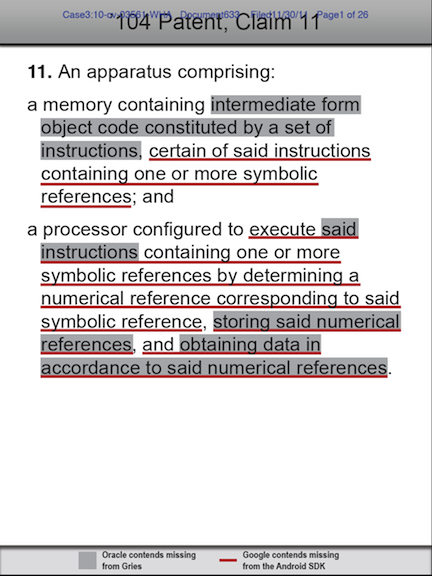
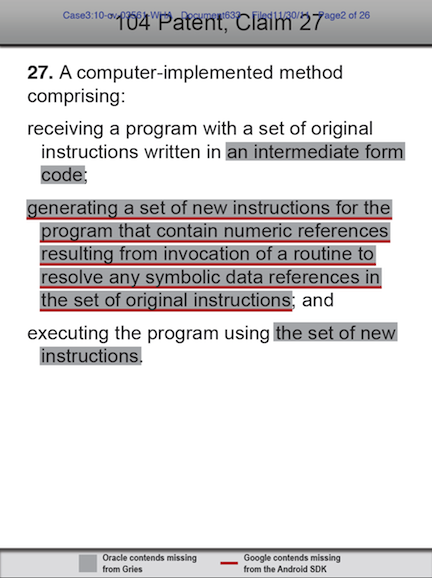
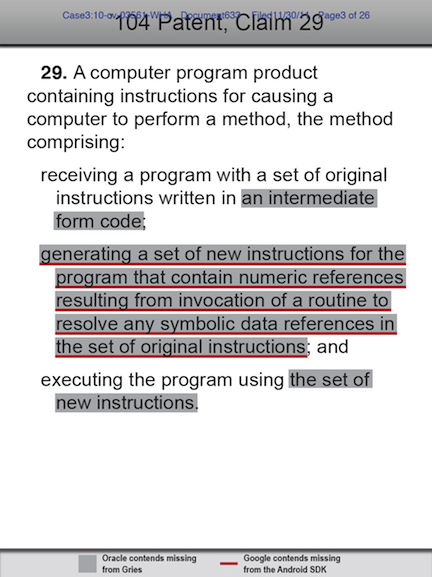
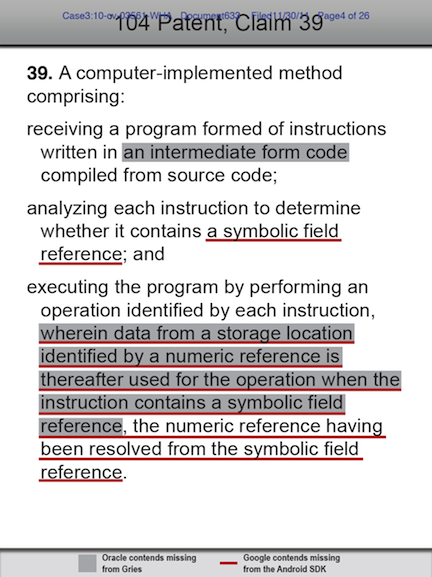
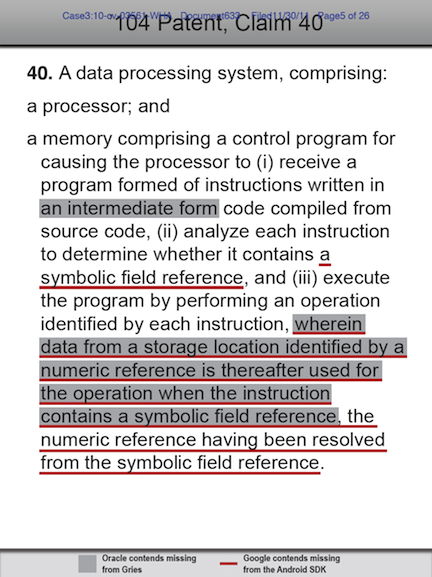
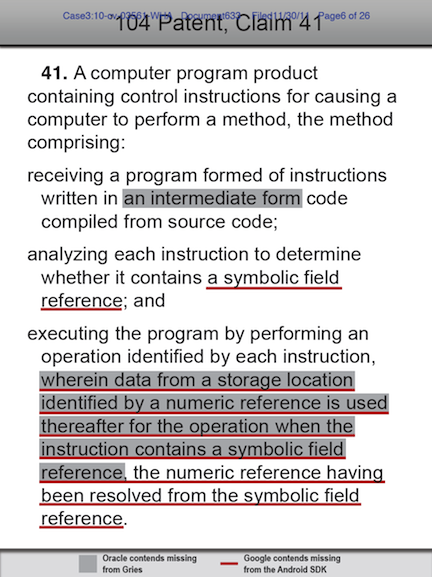
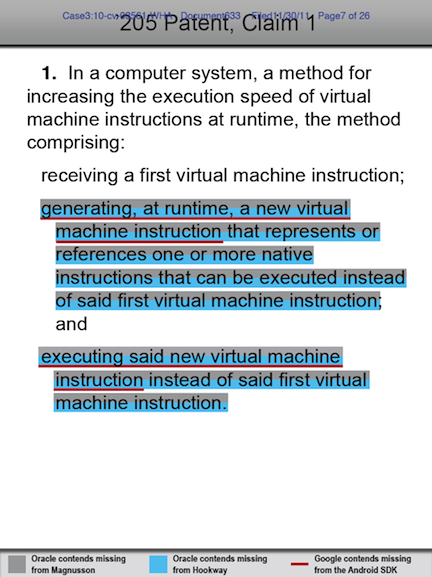
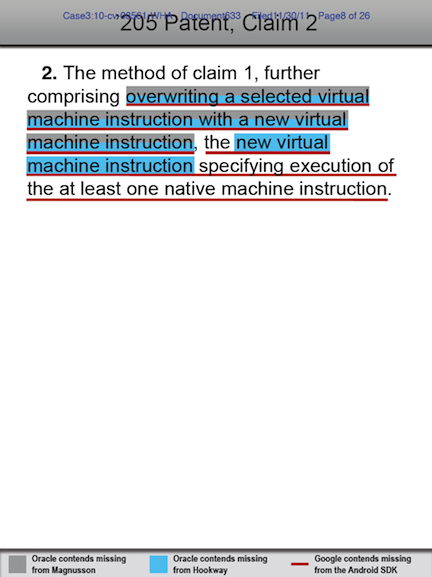
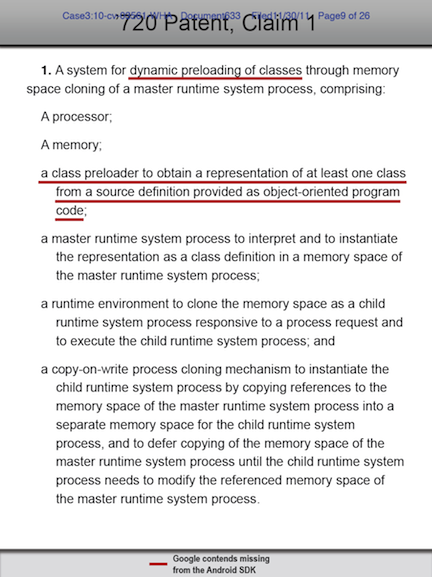
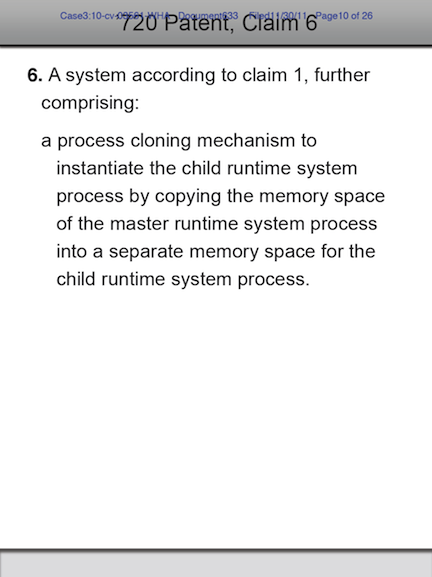
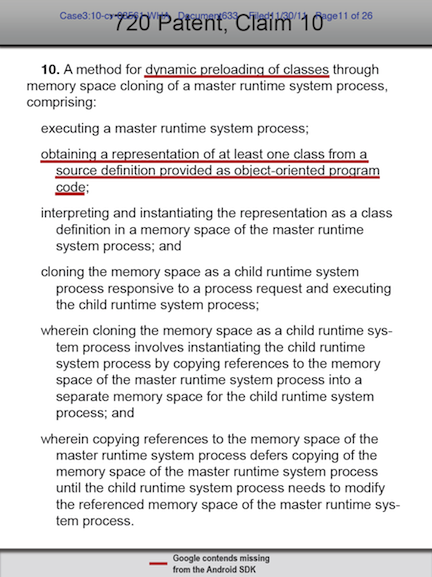
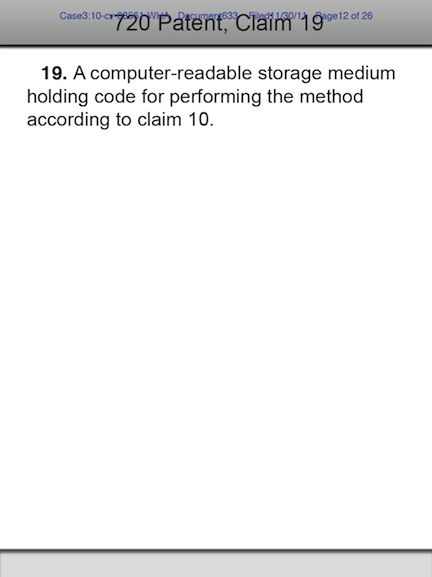
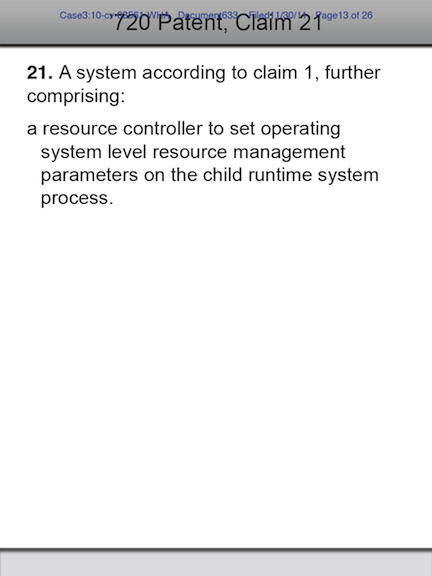
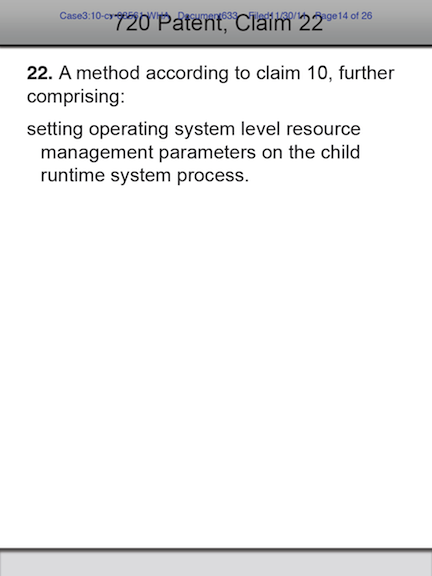
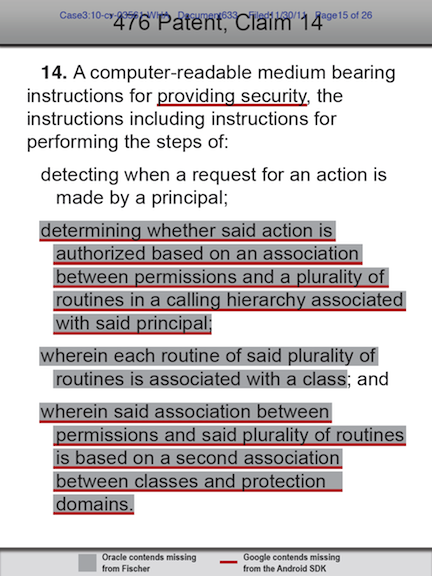
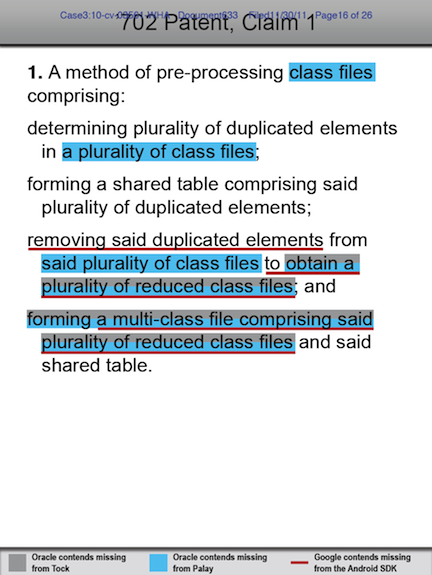
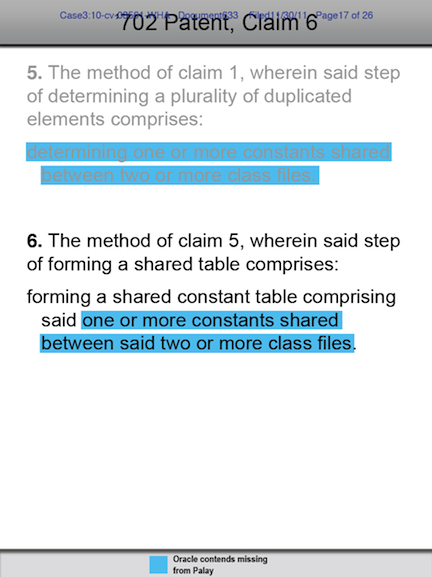
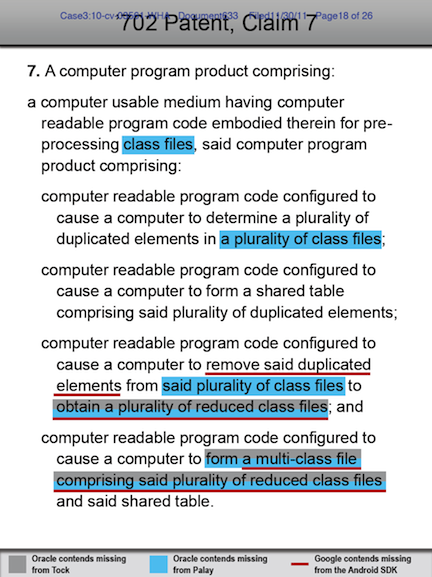
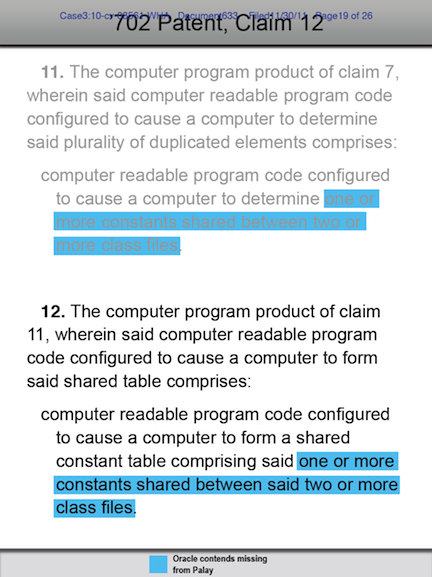
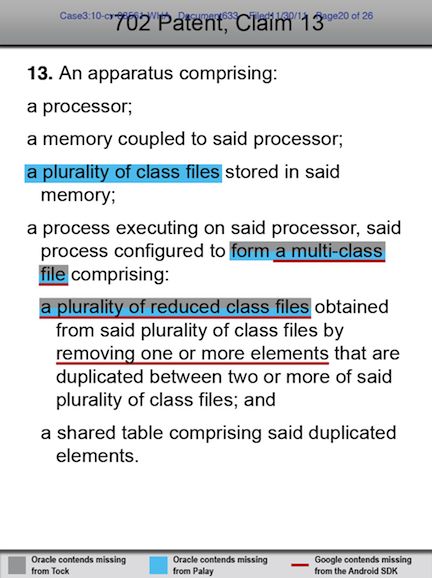
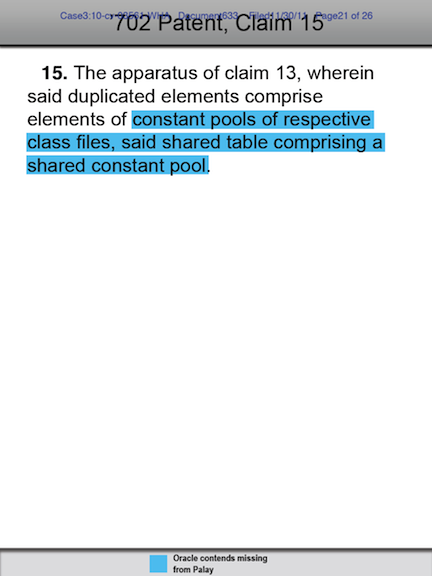
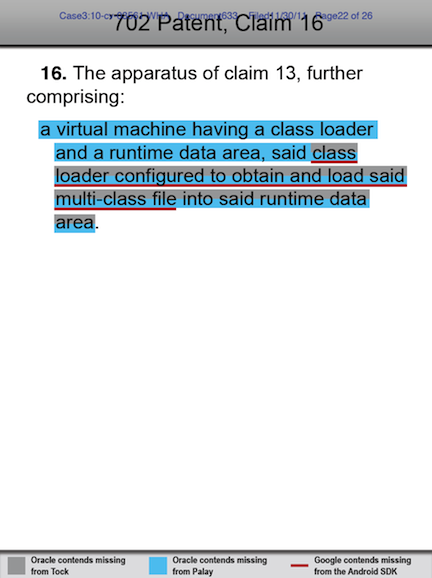
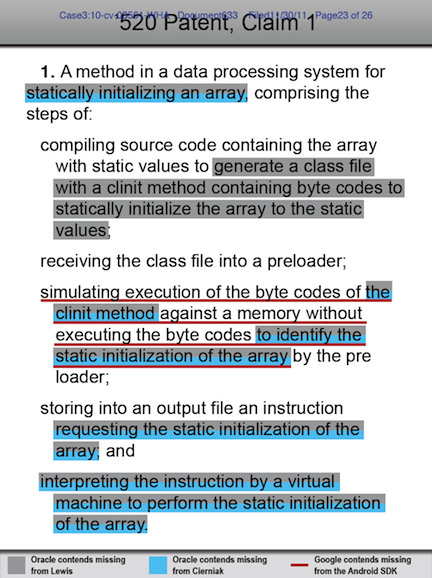
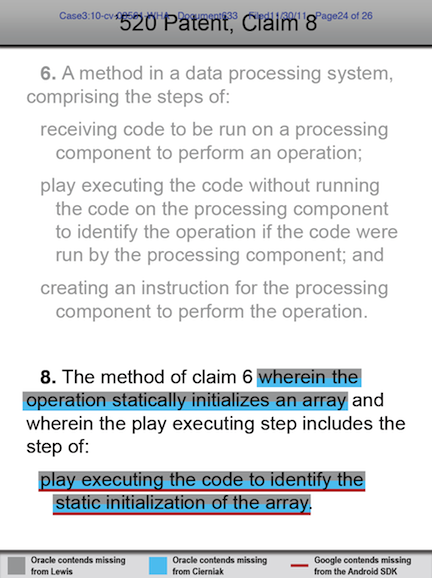
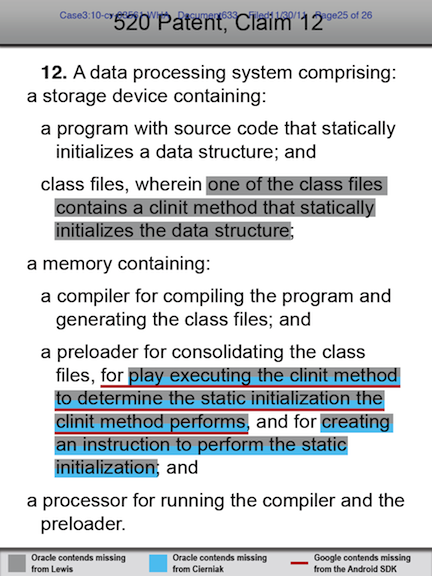
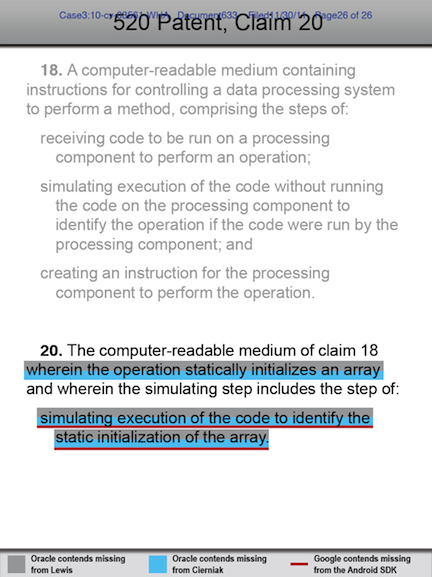
634
[Morrison Foerster letterhead]
November 30, 2011
The Honorable William H. Alsup
United States District Court, Northern District of California
450 Golden Gate Avenue
San Francisco, California 94102
Re: Oracle America, Inc. v. Google Inc., No. 3:10-CV-03561-WHA (N.D. Cal.)
Dear Judge Alsup:
I write to address the Court’s concern, expressed in its November 15, 2011 order (ECF No.
621), regarding potential trial complications arising from questions about which Oracle
products practice the asserted patent claims.
Oracle does not foresee this issue taking significant additional trial time. Oracle’s evidence
will be presented to the jury in two parts. First, Oracle’s experts, as part of their testimony
regarding Google’s infringement and the validity of the claims, will discuss the technology the
claims embrace (as informed by the Court’s claim constructions). That testimony would be
elicited regardless of questions about Oracle’s products. Second, Oracle’s percipient
witnesses, namely, Java software engineers, will testify about which Oracle products do and do
not include the relevant technologies.
As for Google, we know from its expert reports that it will not be presenting expert testimony
on whether Oracle’s products practice the asserted claims. Nor does its witness list disclose
percipient witnesses, other than Oracle engineers, who will testify on this topic. Thus
Google’s presentation of evidence will be limited to cross-examination of Oracle’s witnesses.
Based on the discovery Google took on this issue, we anticipate that this will not be timeconsuming.
Google deposed the Java software engineers who will testify about the products
and so has already had the opportunity to examine them. The questioning was not lengthy,
perhaps because their testimony was supported by the source code that Oracle produced that
corroborates which products contain which technologies.
Respectfully submitted,
/s/ Michael A. Jacobs
Michael A. Jacobs
635
UNITED STATES DISTRICT COURT
NORTHERN DISTRICT OF CALIFORNIA
SAN FRANCISCO DIVISION
ORACLE AMERICA, INC.,
Plaintiff,
v.
GOOGLE INC.,
Defendant.
Case No. 3:10-cv-03561-WHA
GOOGLE’S STATEMENT RE THE
COURT’S NOVEMBER 15, 2011 ORDER
DENYING MOTION FOR PARTIAL
SUMMARY JUDGMENT LIMITING
DAMAGES BASED ON PATENT
MARKING STATUTE
Judge: Hon. William Alsup
INTRODUCTION
In its November 15, 2011 Order denying Google’s motion for partial summary judgment,
the Court recognized that Oracle’s ability to recover damages would be limited by its failure to
mark the products made by it or its licensees that practice the patents, pursuant to the patentmarking
statute, 35 U.S.C. § 287(a).1
The Court went on to express its concern that the trial
would be complicated by an “‘infringement’ type analysis” of Oracle products to determine if
they practiced the patents-in-suit. Accordingly, the Court directed each party to submit a brief
statement describing how this issue might complicate trial and how any such complication could
be mitigated.
The Court’s concern is well founded. Both parties intend to present evidence of the
practice (or failure to practice) by Oracle and/or its licensees of each of the six patents still being
asserted by Oracle in this action. Indeed, Oracle has designated no fewer than seven witnesses to
testify regarding “products that practice the asserted claims of the patents-in-suit.”2
Presentation
of this evidence will add time and complexity to an already complicated trial. The best way to
mitigate the effect of this issue at trial is to require the parties to narrow the issue now, by
identifying the patents (if any) over which there is a legitimate dispute about whether Oracle or
its licensees practiced the asserted claims. Any remaining complications from the marking issue
can be mitigated by proceeding with the Court’s announced plan to trifurcate the trial, with
copyright liability issues tried in phase one, patent liability in phase two, and damages and
willfulness in phase three.
GOOGLE’S STATEMENT
A. Disclosure of the parties’ contentions on practice now will reduce the amount of
time at trial that would need to be devoted to marking issues.
To determine how marking issues will affect the trial, Oracle should immediately resolve
the contradictions in its representations to this Court. Simply stated, does Oracle allege that any
of its (or its licensees’) Java-related products practice the 26 asserted patent claims?
_________________________________
1 Dkt. No. 621 at 2:23-3:1, 4:11-13.
2 Plaintiff Oracle’s Fed. R. Civ. P. 26(a)(3) Witness List (Dkt. No. 525-2).
1
Throughout the course of this litigation, Oracle has argued that this case is about “Java.”
It has broadly characterized the patents-in-suit as “Java” patents,3
represented that the asserted
patents were implemented by its “Java” products, and asserted that the patents as a group are
crucial to the use of Java. Oracle’s infringement contentions identified numerous of its Java
products as allegedly implementing each of the asserted patents.4
Oracle and its damages expert
have argued for enormous monetary damages and an injunction for alleged infringement by
Google of “Java patents.”5
Oracle repeatedly refers to the patents-in-suit as “Java related
patents” in its trial brief. Oracle employees testified at Rule 30(b)(6) depositions that the ‘104,
‘205 and ‘702 patents were implemented in Oracle’s Java products.6
Oracle’s patent validity
expert attempted to demonstrate commercial success of the patents (to rebut evidence of
obviousness under the secondary considerations doctrine) by claiming that Oracle’s products
practiced the ‘104, ‘205 and ‘476 patents.7
And Oracle made the same argument in
reexamination proceedings of the ‘720 patent.8
Despite its repeated rhetorical claims that its products practice the patents, Oracle seems
to have proof problems. For example, it refused to provide a Rule 30(b)(6) witness to testify
regarding practice of the ‘520 or ‘720 patents, stating: “We can confirm that we will not present
an Oracle employee or officer at trial to testify regarding the conception, reduction to practice, or
actual use of the inventions of the ‘520 and ‘720 patents.”9
And then, despite its constant
_____________________________
3 See, e.g., February 9, 2011 Hr’g. Tr. (Dkt. No. 87) at 8; Oracle’s Trial Brief (Dkt. No. 536) at 2.
4 Oracle’s Second Supplemental Patent Local Rule 3-1 Disclosure of Asserted Claims and
Infringement Contentions (Ex. B. to the Van Nest Decl. (Dkt. No. 552-3)).
5 See, e.g., September 12, 2011 Expert Report of Dr. Iain M. Cockburn Report at 8, 9, 25, 37.
6 John Pampuch testified on July 29, 2011 regarding the ‘702 patent, and Peter Kessler testified
on August 4, 2011 regarding the ‘104 and ‘205 patents.
7 August 25, 2011 Expert Report of Dr. Benjamin F. Goldberg at 127-28, 131-32, at 144. Dr.
Goldberg’s report, however, contained no expert analysis supporting his conclusory assertion
that the asserted claims were practiced in Java products. In fact, Oracle failed to offer any expert
report or analysis on practice of any of the patents-in-suit.
8 July 5, 2011 Response to First Office Action at 39 (“Patent Owner developed a commercial
embodiment of the ‘720 Patent called Connected Device Configuration-Application
Management System (CDC AMS).”).
9 Exhibit A, August 9, 2011 email from Daniel P. Muino. Nor did Oracle furnish an expert
report or analysis on practice of the ‘520 or ‘720 patents. Thus, pursuant to the Court’s
Supplemental Order (Dkt. No. 26 at ¶23(c)), Oracle may not offer testimony at trial on the practice of either the ‘520 patent or the ‘720 patent.
2
drumbeat of claims that the patents are essential to Java, Oracle opportunistically reversed course
when opposing Google’s motion for partial summary judgment on marking, claiming that its
products do not necessarily practice the asserted claims.10
Oracle should not be permitted to have it both ways and come to trial with two directly
conflicting factual positions. If Oracle maintains that its products practice the patents, then it
bears the burden of proving that it marked those products accordingly.11
Alternatively, if Oracle
now maintains that its Java products do not practice the asserted patent claims, Oracle’s trial
story that Google allegedly practices its key patented “Java” technology is false and misleading
to the jury. Indeed, if Oracle’s position for marking purposes is that there is no proof that its
products practice the asserted claims, then Oracle should not be permitted, in connection with its
patent case, to describe the patents as “key Java technology.” Moreover, failure to practice
would only further undermine Oracle’s already wildly-exaggerated patent damages calculations,
as those calculations rely upon alleged harm to Oracle’s “Java” products and purported
fragmentation of “Java” technology, and altogether fail to adopt a reasonable valuation for
“Java” patents that even Oracle itself had no use for. And it would also severely undermine the
fundamental premise of Oracle’s request for an injunction, namely Oracle’s allegation that it
“practices . . . the six Java-related patents” and an injunction is therefore necessary to “prevent
Google from further fragmenting the Java platform and undermining Oracle’s and others’
investments in Java.”12
In short, Oracle needs to take a position on whether its products or those of its licensees
practice the patents-in-suit and stick to it. Google proposes that by December 9, 2011, for each
of the 26 asserted patent claims, Oracle identify each Oracle product or Oracle-licensed product
that allegedly practices the claim, and the time period during which the product allegedly was
______________________________
10 Dkt. No. 577 at 2.
11 See Nike, Inc. v. Wal-Mart Stores, Inc., 138 F.3d 1437, 1446 (Fed. Cir. 1998) (cited in
Google’s Motion for Partial Summary Judgment (Dkt. No. 552) at 4).
12 Oracle’s Trial Brief (Dkt. No. 568) at 27:24-28:5.
3
marked.13 By December 16, Google will respond and identify which contentions in Oracle’s
submissions it would be able to stipulate to, and which contentions it will challenge at trial. The
above disclosures could resolve most, if not all, of the marking dispute, and will significantly
shorten the time that will need to be allocated to this issue at trial.
Imposing an immediate deadline for these disclosures is important given that Dr. Kearl is
expected to submit his damages report on January 19, 2012 (Dkt. No. 575). If Oracle concedes
that its products do not practice one or more of the asserted patent claims, Dr. Kearl may wish to
take that into account. Likewise, if Oracle maintains that its products do implement the asserted
patent claims but were not marked, Dr. Kearl may wish to take that into account as well.
B. Trifurcating the trial would further mitigate complications from the marking issue.
To the extent any disputes remain in view of the above disclosures (or should the Court
not require such disclosures) both Google and Oracle will need to present evidence concerning
whether or not Oracle (or Oracle-licensed) products practiced the patents-in-suit before July 20,
2010—the date upon which Oracle first notified Google of alleged infringement. Presentation of
this evidence will add time and complexity to the patent liability and damages cases, but the
evidence is irrelevant to the copyright case. Trifurcation will allow the jury to decide copyright
liability without being bogged down by specific, individualized evidence about whether Oracle
(or Oracle-licensed) products practiced any of the patents-in-suit.14
There are at least seven percipient
witness Oracle employees who allegedly have knowledge regarding “products that practice the
asserted claims of the patents-in-suit”: Mark Reinhold, Guy Steele, Peter Kessler, Erez Landau,
____________________________
13 Oracle already has conceded that it “is not aware of any device, system, or product expressly
marked with the patent number of any of the Patents-in-Suit or any Related Patents . . .” Oracle
Response to Request for Production No. 4 (Ex. B. to the Van Nest Decl. (Dkt. No. 552)).
14 Google notes, however, that the patentee bears the burden of proof with respect to marking.
See Nike, Inc. v. Wal-Mart Stores, Inc., 138 F.3d 1437, 1446 (Fed. Cir. 1998).
4
John Pampuch, Noel Poore, and Bob Vandette.15 Google will question these witnesses (and/or
other former Sun or Oracle employees on Oracle’s or Google’s witness lists) about whether
(1) Oracle’s or its licensees’ products practiced the claims of the patents-in-suit that Oracle is
asserting at trial; and (2) Oracle or its licensees sold, offered to sell, or imported those products
into the United States before July 20, 2010. Google will support its examination of these
witnesses with contemporaneous documentary evidence. Google expects that Oracle will elicit
testimony from these same witnesses on these same issues, as Oracle’s witness list suggests.
Presentation of this evidence—by both Google and Oracle16—will inevitably add time
and complexity to the patent and damages cases. But the evidence of practice of these patents is
irrelevant to the copyright case. The severability of complex issues like whether Oracle or its
licensees practiced the patents further supports the need for the trifurcated trial outlined by the
Court.17 Because the jury does not need to hear evidence of whether the patents were practiced
to decide copyright liability, the Court’s proposed trifurcated trial structure would allow the
Court to mitigate the complicating effect of that evidence by excluding it from phase one of the
trial. Accordingly, aside from requiring the disclosures as suggested in Part A, above,
trifurcation is the most effective way to prevent the trial from being unnecessarily complicated
by evidence of Oracle’s or its licensees’ practice (or failure to practice) the patents-in-suit.
Dated: November 30, 2011
KEKER & VAN NEST LLP
By: s/ Robert A. Van Nest
ROBERT A. VAN NEST
Attorneys for Defendant
GOOGLE INC.
____________________________
15 Plaintiff Oracle’s Fed. R. Civ. P. 26(a)(3) Witness List (Dkt. No. 525-2).
16 Oracle apparently intends to offer evidence of its own practice of the patents in order to
“show[] non-obviousness of the patents and demand for the inventions.” See Oracle Opposition
to Google’s Motion for Partial Summary Judgment (Dkt. No. 577) at 1:10-14; see also id. at
2:27-3:2, 3:8-12.
17 See, e.g., Bates v. United Parcel Serv., 204 F.R.D. 440, 448 (N.D. Cal. 2001) (bifurcating the
trial because “the issues of liability and damages are separable in this case”); Ciena Corp. v.
Corvis Corp., 210 F.R.D. 519, 520 (D. Del. 2002) (severing complex patent case into several
phases in order to “reduce[] the number of legal principles the jury must consider and apply” at
any given time); see also Oracle’s Critique of the Court’s Proposed Trial Plan (Dkt. No. 627)
(urging the Court to consider the degree to which the issues for trial are separable in deciding
whether to trifurcate the trial).
5
|
|
|
|
| Authored by: jesse on Thursday, December 01 2011 @ 11:10 AM EST |
| Thank you. [ Reply to This | # ]
|
| |
| Authored by: jesse on Thursday, December 01 2011 @ 11:11 AM EST |
| Thank you. [ Reply to This | # ]
|
| |
| Authored by: jesse on Thursday, December 01 2011 @ 11:12 AM EST |
| Thank you. [ Reply to This | # ]
|
| |
| Authored by: jesse on Thursday, December 01 2011 @ 11:13 AM EST |
| Thank you. [ Reply to This | # ]
|
- COMES 1188 - Authored by: qubit on Thursday, December 01 2011 @ 01:00 PM EST
- COMES 0691 - Authored by: qubit on Thursday, December 01 2011 @ 01:01 PM EST
- COMES 9438 - Authored by: qubit on Thursday, December 01 2011 @ 01:02 PM EST
- COMES 9372 - Authored by: qubit on Thursday, December 01 2011 @ 01:03 PM EST
- COMES 0732 - Authored by: qubit on Thursday, December 01 2011 @ 01:09 PM EST
- COMES 1382 - Authored by: qubit on Thursday, December 01 2011 @ 02:04 PM EST
- COMES 0744 - Authored by: qubit on Thursday, December 01 2011 @ 04:33 PM EST
- COMES 0744 - Authored by: PJ on Wednesday, December 07 2011 @ 01:38 AM EST
| |
| Authored by: FreeChief on Thursday, December 01 2011 @ 12:29 PM EST |
| It certainly does not look good for Oracle to be asserting both A and not A, but
why did they need to say anything?
I have always thought that patent law
would be improved by a requirement that the plaintiff actually practice
the claimed invention (or license it to one who does). But we have
Non-Practicing Entities (trolls), so I assumed that there was no such
requirement.
What does the law require? How can there be a duty to mark, if
there is no duty to practice the patent at
all?
— Programmer in Chief
[ Reply to This | # ]
|
| |
| Authored by: Anonymous on Thursday, December 01 2011 @ 01:05 PM EST |
| Disclaimer: I am not a lawyer. But let's have a close look at Google's
statements.
By Google:
"...Alternatively, if Oracle now
maintains that its Java products do not practice the asserted patent claims,
Oracle’s trial story that Google allegedly practices its key patented “Java”
technology is false and misleading to the jury.
Question is:
Do Oracle's [Java] patents in-suit have to be practiced by Oracle's or its
licensees in order for them to be deemed key Java technologies?
I do not
think so, because no sane technologist can say that every Java practicing
hardware contains identical technologies as every other. Some could only be
implementing a subset of Java technology.
Further:
"Indeed, if
Oracle’s position for marking purposes is that there is no proof that its
products practice the asserted claims, then Oracle should not be permitted, in
connection with its patent case, to describe the patents as “key Java
technology.”
Google's objection to the terms, "key Java
technology" would be better received if it proposed an "acceptable" term or
terms to employ. Interpretation of the word "key" here is very subjective.
[ Reply to This | # ]
|
- Google's quoting Oracle - Authored by: cpeterson on Thursday, December 01 2011 @ 01:36 PM EST
- Not likely - Authored by: cjk fossman on Thursday, December 01 2011 @ 01:42 PM EST
- Not likely - Authored by: Anonymous on Thursday, December 01 2011 @ 02:56 PM EST
- I am afraid Google could be seen to be attempting to mislead... - Authored by: Anonymous on Thursday, December 01 2011 @ 01:53 PM EST
- ROFL - that's funny - Authored by: Anonymous on Thursday, December 01 2011 @ 03:20 PM EST
- I agree, but - Authored by: cjk fossman on Thursday, December 01 2011 @ 04:44 PM EST
- I agree, but - Authored by: matth on Thursday, December 01 2011 @ 05:00 PM EST
- I agree, but - Authored by: greed on Thursday, December 01 2011 @ 06:04 PM EST
- I agree, but - Authored by: Anonymous on Thursday, December 01 2011 @ 08:16 PM EST
- Misses the point - Authored by: Anonymous on Thursday, December 01 2011 @ 06:48 PM EST
- I agree, but - Authored by: Anonymous on Friday, December 02 2011 @ 01:42 AM EST
| |
| Authored by: complex_number on Thursday, December 01 2011 @ 01:07 PM EST |
<blockquote>
Oracle should not be permitted to have it both ways and come to trial with two
directly conflicting factual positions.
</blockquote>
<P>
It is clear that Oracle are trying to get themselves into a position where this
is the case.
<P>
Google have see this 'not so cunning plan' are call them on it.
<P>
AFAIK, IANAL etc, Google seem to be telling the Judge that ORacle is trying to
blindside him and he should stop it.
<P>
I'd expect the google legal team are already preparing the motions of objection
and even appeal if he does not put a stop to this.
<P>
---
Ubuntu & 'apt-get' are not the answer to Life, The Universe & Everything which
is of course, "42" or is it 1.618?
[ Reply to This | # ]
|
| |
| Authored by: SilverWave on Thursday, December 01 2011 @ 01:18 PM EST |
yeah nice.
Reducing it to mutually contradictory statement.
Spot on.
---
RMS: The 4 Freedoms
0 run the program for any purpose
1 study the source code and change it
2 make copies and distribute them
3 publish modified versions
[ Reply to This | # ]
|
| |
| Authored by: Anonymous on Thursday, December 01 2011 @ 03:26 PM EST |
It just dawned on me that BSF likely has a hand in that position Oracle has
presented. It seems very much like what we saw over and over in other
cases.
For purposes of damages, we claim X. However, due to Law requiring
us to prove that, for purposes of proof, we claim !X.
RAS[ Reply to This | # ]
|
| |
| Authored by: Anonymous on Thursday, December 01 2011 @ 04:08 PM EST |
Reading these patents makes me think it's easy to find prior art.
The broader they are the easier it gets.
Example 1: 104 Patent claim 11 up to 27
The Pet 2000 basic interpreter.
The moment you enter program code it is stored with tokens
into memory (the token is obviously a object)
The token is a numerical reference (even a offset) to a routine that can resolve
the data contained in the memory space next to the token
(Token with data is also a object).
btw: it's also JIT to run after the last line of code is entered into the
system.
Example 2: 104 Patent claim 41
This is a short one.
Nested to deep error in line 10
>?
Example 3: 476 Patent Claim 14
"A computer-readable medium" Nowadays a computer can read
any medium from paper back to a stone tablets of Moses,
So this will void this patent already.
But if i go to the principal (headmaster) with some instructions carved in stone
he will first determine whether said action
is authorized by .... with said principal. (lets say him self).
ok folks lets fine more prior art
/Arthur
[ Reply to This | # ]
|
| |
| Authored by: darrellb on Thursday, December 01 2011 @ 05:34 PM EST |
If Oracle practices the patents but didn't mark the product, Oracle has a
damages problem.
If Oracle doesn't practice the patents, Oracle has a damages problem.
---
darrellB[ Reply to This | # ]
|
| |
| Authored by: Anonymous on Thursday, December 01 2011 @ 06:27 PM EST |
Can anyone understand those claim charts? The coloring gives me a headache and
only makes it harder to see what's what. I don't know how to fix them, but
right now, they're hard on the eyes. Maybe it's just the colors. I'm not sure,
but they're hard for me to read.[ Reply to This | # ]
|
- Unreadable - Authored by: DaveJakeman on Friday, December 02 2011 @ 08:57 AM EST
- Unreadable - Authored by: Anonymous on Saturday, December 03 2011 @ 01:01 AM EST
| |
| Authored by: Anonymous on Saturday, December 03 2011 @ 07:54 PM EST |
This may seem like a silly question, but I have a lot of "hardware"
here
ranging from antique guns (patent date 1895) to current computers. Finding
patent markings on physical items is easy.
With Java, I could write a program that you could run on your computer.
You would never see Java itself operating, you would just see my program.
So there would be no way to tell if it was marked.
[ Reply to This | # ]
|
|
|
|
|



